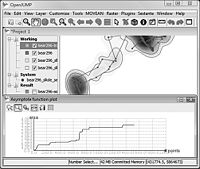Difference between revisions of "Movement Analysis"
m |
|||
| Line 1: | Line 1: | ||
| − | We have create a toolbox for the free GIS software [http://www.openjump.org OpenJUMP] that allows to analyse movement data, called '''OpenJUMP HoRAE''' - '''Ho'''me '''R'''ange '''A'''nalysis and '''E'''stimation (pronounced: ''horay''). The software is and can be freely distributed under the [http://www.gnu.org/licenses/gpl-2.0.txt General Public License verison 2.0 (GPL)]. | + | We have create a toolbox for the free GIS software [http://www.openjump.org OpenJUMP] that allows to analyse movement data, called '''OpenJUMP HoRAE''' - '''Ho'''me '''R'''ange '''A'''nalysis and '''E'''stimation (pronounced: ''horay''). The software is and can be freely distributed under the [http://www.gnu.org/licenses/gpl-2.0.txt General Public License verison 2.0 (GPL) - so you can give it to your co-worker or even modify it]. |
== About the Home Range Analysis Toolbox == | == About the Home Range Analysis Toolbox == | ||
Revision as of 12:57, 31 October 2011
We have create a toolbox for the free GIS software OpenJUMP that allows to analyse movement data, called OpenJUMP HoRAE - Home Range Analysis and Estimation (pronounced: horay). The software is and can be freely distributed under the General Public License verison 2.0 (GPL) - so you can give it to your co-worker or even modify it.
About the Home Range Analysis Toolbox
The toolbox contains functions for visualization of movement tracks and allows the creation and analysis of animal home ranges. Home range estimation methods that have been implemented are (see also the article below):
- Minimum Convex Polygon (MCP),
- Kernel Density Estimation (KDE), methods: (a) href, (b) LSCV, and (c) ad-hoc (region split)
- Line-based KDE, scaled and un-scaled
- Brownian Bridges
- Line Buffer
- Local Convex Hulls (LoCoH), methods: radius r, k-1 nearest neighbors, alpha region.
Additionally one can:
- perform an Asymptote analysis for MCP, Point-KDE, Line-Buffer
- Calculate core areas
- Classify home range parts
- derive the Skeleton for a home range region.
- analyze the daily travel
The toolbox was originally developed to analyse location data from grizzly bears (ursus arctos) collected with GPS collars within the Grizzly Bear Programm of the Foothills Research Institute (FRI, Alberta, Canada). Funding was provided by Canadian Phase IV GEOIDE grant (#3).
Download
The software should run on Windows and Linux systems. Currently there is a bug that does not allow saving data on MacOSX systems. However, if you write me (Stefan: sstein) I can send you a patched version that allows saving to file put can't save to a database. Anyway - here to the downloads:
- download software (package including OpenJUMP 1.4 with the HoRAE toolbox)
- install instructions - note, the software requires Java Runtime Environment (JRE) installed
- a short article (pdf) that describes the functions of the toolbox (article under submission)
finally some preliminary results for grizzly bear data: GIScience 2010 extended abstract (pdf) and poster (pdf)
Documentation
We work on a wiki page with some more online documentation. However, the ABODE manual may be a good start, since most functions implemented were "inspired" by the ABODE toolbox (but softwares calculations are differently). For now you may check our Home Range Calculation Manual, which contains some info on how using our toolbox.
Contact
You can contact me, Stefan Steiniger, writing an email to sstein(=at=)geo.uzh.ch. Alternatively you may contact Andrew Hunter.
